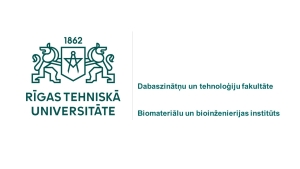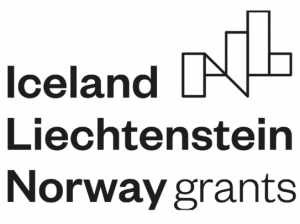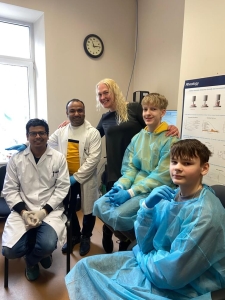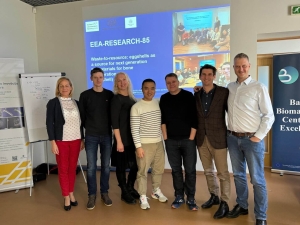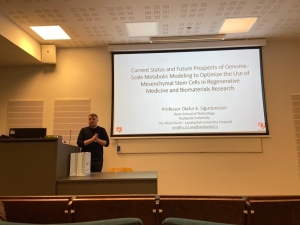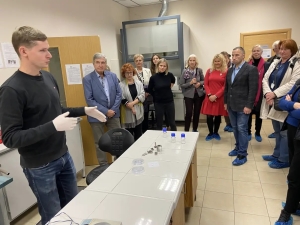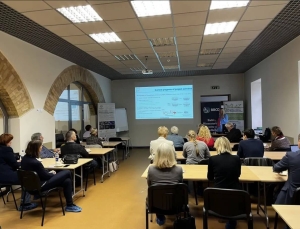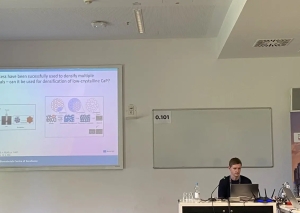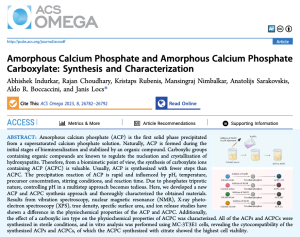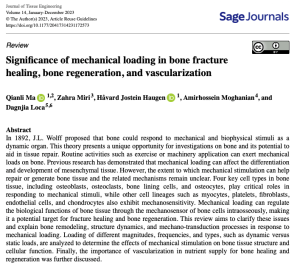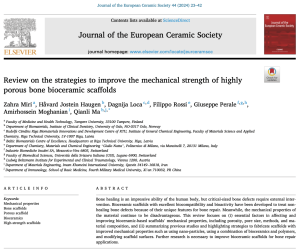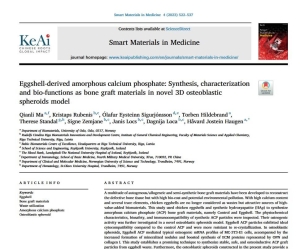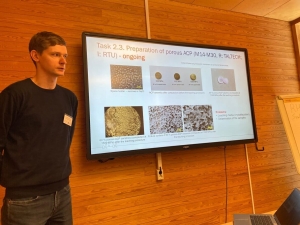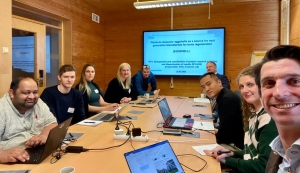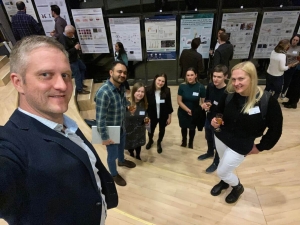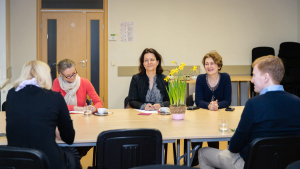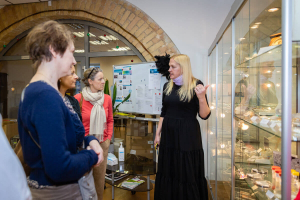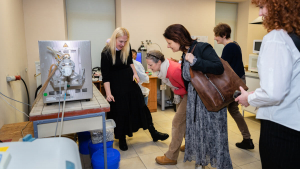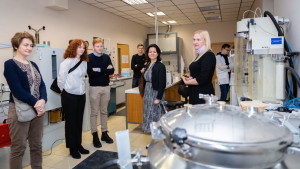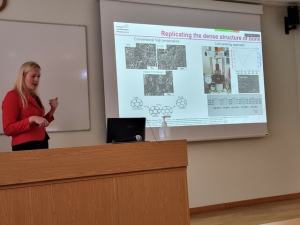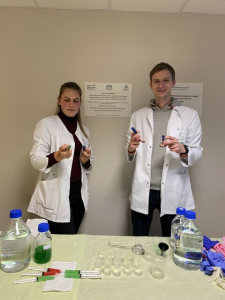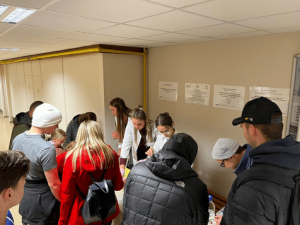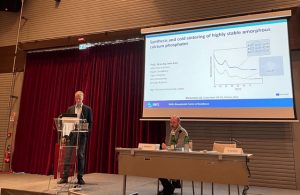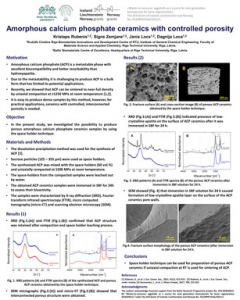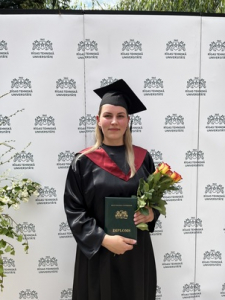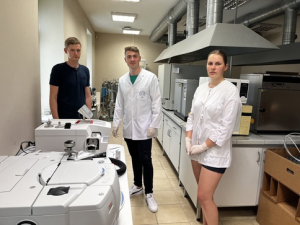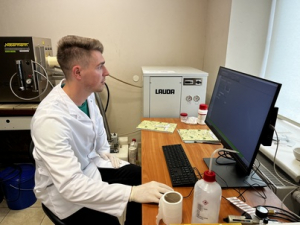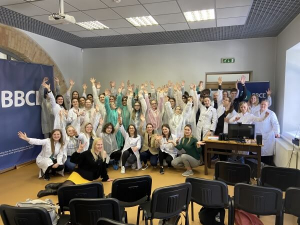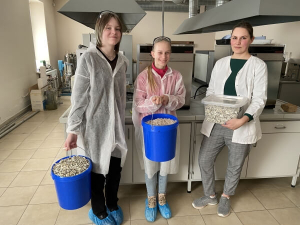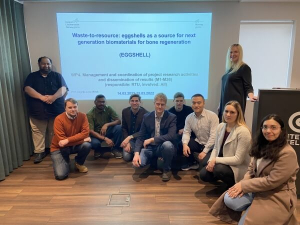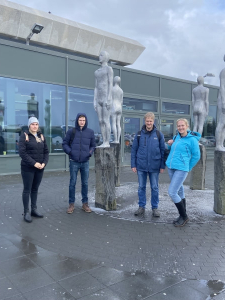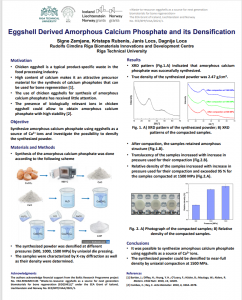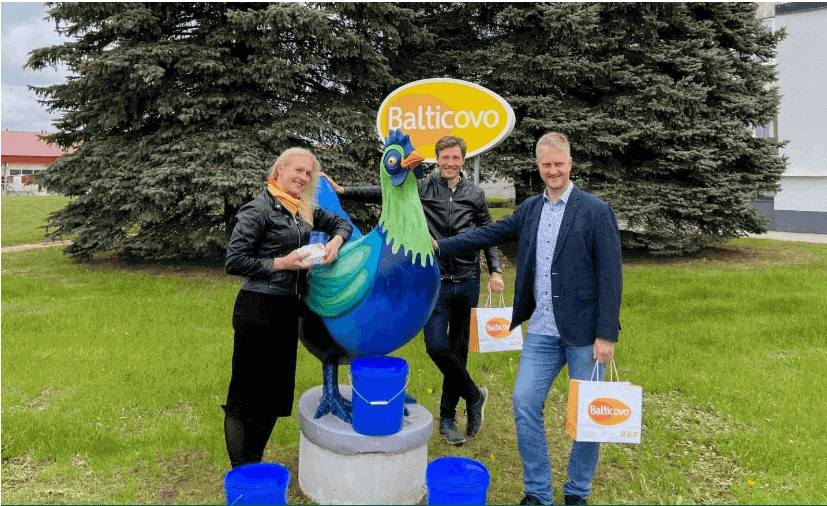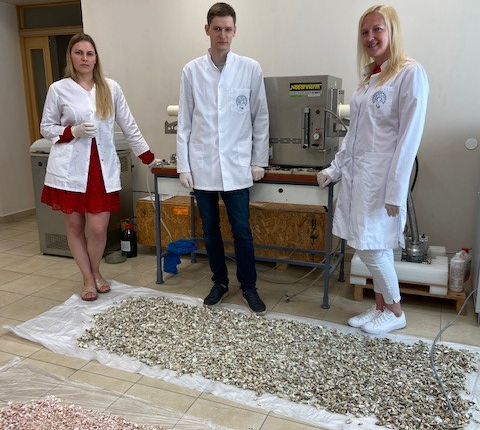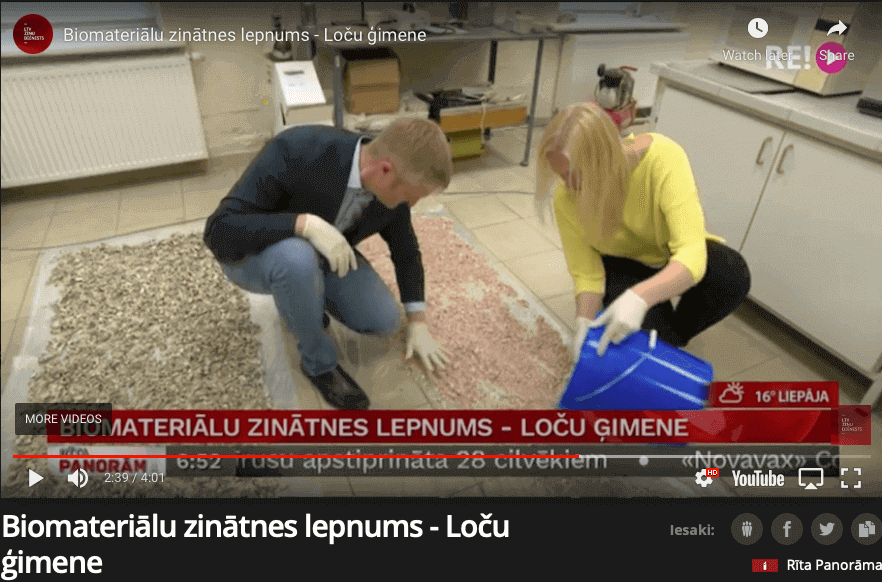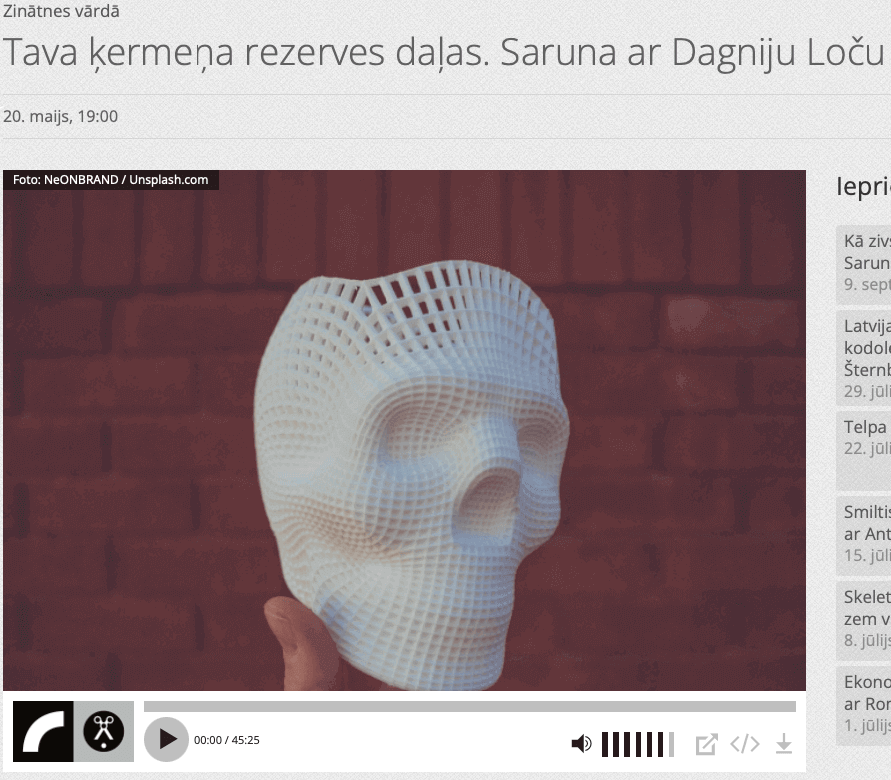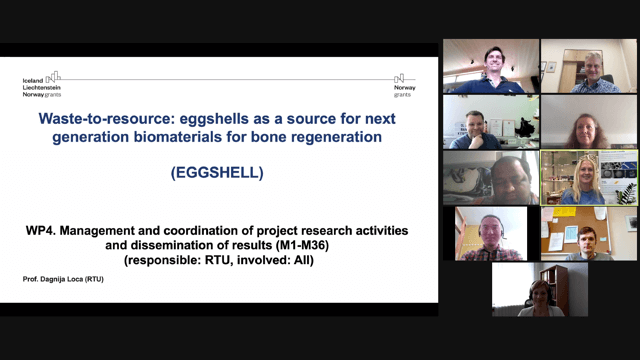January – April, 2024
April 20 – participants of the EGGSHELL project have significantly exceeded the initial target for scientific publications set at the beginning of the project. Initially, three publications were anticipated to be published during the project. However, project participants have already published eight articles and three more publications are currently under consideration. The publications are published in scientific journals such as Smart Materials in Medicine, Materials Today: Proceedings, and Journal of the European Ceramic Society. More publications are being prepared based on the findings achieved during the project.
On April 4, during Job Shadow Day 2024, EGGSHELL project coordinator Dagnija Loca introduced two 6th grade school children to the researcher profession at the Institute of Biomaterials and Bioengineering at RTU. The school children had an opportunity to learn how eggshells can be used for the synthesis of biomaterials using electrospraying and what challenges scientists can face when developing these innovative systems.
On April 4, the EEA-RESEARCH-85 project “Application of Waste-to-Resource Strategies for the Transformation of Eggshell Waste into Next-Generation Biomaterials for Bone Regeneration” partner meeting was held in Riga, Latvia. The meeting reviewed the progress made and discussed future plans. In its third year, the project focused on scaling up the synthesis of amorphous calcium phosphate, developing porous amorphous calcium phosphate ceramic scaffolds, and characterizing their biological properties. All project goals were successfully achieved. Project partners are planning to undertake future joint research projects.
On April 5, the final conference of the EGGSHELL project took place, featuring presentations from the project participants. Qianli Ma (University of Oslo) presented “Bio-evaluation of Eggshell products, in vitro and in vivo studies”, sharing the project findings with students and professors from Riga Technical University. Additionally, Olafur Eysteinn Sigurjonsson (Reykjavik University) delivered a presentation “Current status and future prospects of genome-scale metabolic modeling to optimize the use of mesenchymal stem cells in regenerative medicine and biomaterials research”. EGGSHELL final conference gathered more than 50 participants.
October – December, 2023
On November 2nd, 2023, representatives of the Romanian Certification Authority, Managing Authority, and Audit Authority of the planning period 2014-2021 for the European Economic Area Financial Mechanism and the Norwegian Financial Mechanism visited Riga Technical University (RTU). They were familiarized with the best practices during the visit and exchanged experiences. The focus of the visit was to gain knowledge about the Baltic Research Program project “Waste-to-resource: eggshells as a source for next-generation biomaterials for bone regeneration” implemented by RTU.
RTU scientists introduced the representatives to the project’s objectives, challenges faced during the project implementation, and the benefits derived from realising the Baltic Research Program projects.
From October 18th to 19th, 2023, the Baltic Research Program’s mid-term conference, “Collaborative Experience for Shaping the Future of Research”, took place in Riga, Latvia. The conference brought together representatives from the European Economic Area/Norway Research and Education Programme – projects’ promoters and partners from Latvia, Lithuania, Estonia, Croatia, Norway, and Iceland, as well as representatives from the administrative staff of the programme to discuss ways to shape the future based on the experiences with the programme so far.
The conference aimed to explore the diverse and shared experiences of the Research and Education programme projects and to focus on the possibilities and necessities for the future. On October 18th, the conference participants visited various projects of the Latvian Baltic Research Program, including the “Waste-to-resource: eggshells as a source for next generation biomaterials for bone regeneration” (No. EEA-RESEARCH-85) project implemented at Riga Technical University (RTU).
During the visit, conference participants were acquainted with the project’s implementation process, progress, and the benefits of realising the Baltic Research Program project. Additionally, conference participants had a tour of the RTU Rudolfs Cimdins Riga Biomaterial Innovation and Development Centre, where they became familiar with the biomaterials developed at the centre.
July – September, 2023
In September 2023, EEA-RESEARCH-85 project participant Kristaps Rubenis from RTU participated in two international scientific conferences – FEMS EUROMAT 2023 and BIOFABRICATION 2023.
FEMS EUROMAT 2023 took place in Frankfurt, Germany, from September 2.-7. During the conference, K. Rubenis presented an oral presentation titled “Sintering of low-crystalline calcium phosphates by uniaxial compaction at room temperature,” where the results obtained within the EEA-RESEARCH-85 project on sintering of low-crystalline calcium phosphates using uniaxial compaction at room temperature at pressures ≤1.5 Gpa were discussed.
BIOFABRICATION 2023 was held in Saskatoon, Canada, from September 17.-20. K. Rubenis participated in the conference with a poster presentation titled “Sintering of temperature-sensitive calcium phosphates by uniaxial compaction at room temperature,” demonstrating the feasibility of obtaining dense (relative density >90%) low-crystalline calcium phosphate ceramics using uniaxial compaction at room temperature while preserving the starting material phase (low-crystalline apatite, amorphous calcium phosphate, or octacalcium phosphate).
Additionally, participants of the EEA-RESEARCH-85 project have published 3 scientific publications.
1.A scientific paper titled “Amorphous Calcium Phosphate and Amorphous Calcium Phosphate Carboxylate: Synthesis and Characterization” has been published in the scientific journal ACS Omega. The paper presents a novel method for synthesizing amorphous calcium phosphate and carboxylate ion-containing amorphous calcium phosphate. The study compared the physiochemical properties of the synthesized amorphous calcium phosphates by using various characterization techniques and it also examined their cytocompatibility with MC-3T3E1 cells. Notably, citrate ions containing amorphous calcium phosphate demonstrated the highest cell viability. The research offers insights into biomimetic calcium phosphate material synthesis with potential applications in biomineralization and tissue engineering.
2.A review paper titled “Significance of mechanical loading in bone fracture healing, bone regeneration, and vascularization” has been published in the scientific journal Journal of Tissue Engineering. The paper encompassed the scientific literature on the influence of mechanical loading on bone fracture healing, bone tissue regeneration, and vascularization. Since the late 19th century, it has been known that bone tissue responds to mechanical stimuli, which is crucial for their regeneration. Although earlier studies have demonstrated that mechanical loading affects bone tissue, the extent of its contribution to tissue repair and the related mechanisms remain unclear. The review aims to clarify these issues, focusing on bone remodelling and mechanotransduction in response to mechanical loading.
3.Additionally, in the scientific journal Journal of the European Ceramic Society a review paper titled “Review on the strategies to improve the mechanical strength of highly porous bone bioceramic scaffolds” has been published. In this review paper, the scientific literature on strategies for improving the mechanical properties of highly porous bioceramic scaffolds was reviewed. Bone healing is impressive, but critical bone defects require intervention, and bioceramic scaffolds can offer the needed biocompatibility; however, they have poor mechanical properties. The review focused on improving these properties by highlighting strategies like nanoparticles and combining bioceramics with biopolymers. Further research is needed to enhance bioceramic scaffolds for bone repair.
April – June, 2023
In April 2023, the first joint scientific publication by the EEA-RESEARCH-85 project partners was accepted for publication in the scientific journal Smart Materials in Medicine. The study, titled “Eggshell-derived amorphous calcium phosphate: Synthesis, characterization and bio-functions as bone graft materials in novel 3D osteoblastic spheroids model”, compares amorphous calcium phosphates synthesized using eggshells as a source of calcium ions to amorphous calcium phosphates synthesized from commercial hydroxyapatite. The amorphous calcium phosphates synthesized using eggshells showed better cytocompatibility and were more resistant to crystallization. It also mediated typical osteogenic mRNA profiles in osteoblastic spheroids, increased the formation of mineralized nodules, and boosted the synthesis of extracellular matrix protein, demonstrating that amorphous calcium phosphates synthesized using eggshells are promising biomaterials.
January – March, 2023
From March 21-24th, 2023, the 16th Scandinavian Society for Biomaterials (ScSB) conference took place in Roros, Norway, with a scientific program centered on bioinspiration in biomaterials.
The conference was attended by 120 researchers from Scandinavia, the Baltic States, as well as the rest of Europe, Asia, and North America. The EEA-RESEARCH-85 project researchers from Riga Technical University, Signe Zemjāne and Kristaps Rubenis, participated in the ScSB2023 with poster presentations titled “The influence of the synthesis method on the sintering ability of amorphous calcium phosphate and properties of the obtained ceramics” and “Fabrication of porous ceramic scaffolds from amorphous calcium phosphate synthesized from chicken eggshells”.
The EEA-RESEARCH-85 project partners from the University of Oslo and the University of Reykjavik also attended the conference.
On March 22nd, 2023, the EEA-RESEARCH-85 project “Application of Waste-to-Resource Strategies for the Transformation of Eggshell Waste into Next-Generation Biomaterials for Bone Regeneration” partner meeting was held in Roros. During the meeting, the work done within the project so far, as well as future tasks, were discussed. The second year of the research project (the project ends in 2024) is mainly focused on obtaining dense and porous amorphous calcium phosphate ceramic scaffolds using cold sintering and high-pressure torsion methods, as well as characterizing the obtained samples. Work is also continuing on characterizing the biological properties of amorphous calcium phosphate and obtaining proteins from eggshell membranes. Overall, the implementation of the project is proceeding according to the initial work plan
On January 25th, 2023, representatives of the Royal Norwegian Embassy and the Norwegian Ministry of Foreign Affairs visited RTU and learned how the eggshells can be transformed into innovative biomaterials.
Researchers from the Rudolfs Cimdins Riga Biomaterials Innovation and Development Center of RTU (RTU RBIDC) introduced the representatives of the Royal Norwegian Embassy and the Norwegian Ministry of Foreign Affairs to a project where they develop a novel technology for transforming eggshells into the biomaterials for bone regeneration.
The project, “Waste-to-resource: eggshells as a source for next generation biomaterials for bone regeneration (EGGSHELL) (No. EEA-RESEARCH-85),” is one of the projects within the Baltic Research Programme. The programme is supported by the European Economic Area grants, funded by Iceland, Liechtenstein, and Norway (No. EEZ/BPP/VIAA/2021/1). RTU implements the project in collaboration with the University of Oslo (UiO), University of Reykjavik (RU), and Tallinn University of Technology (TalTech).
During the visit to the RTU RBIDC the representative of the Norwegian Ministry of Foreign Affairs, Elin Graae Linnestad met with the project coordinator, Dagnija Loča, who is the RTU leading researcher in the Faculty of Materials Science and Applied Chemistry. They were also accompanied with the Norwegian Embassy advisors Agnese Cimdina and Iveta Medvida, and interns Sara Aurora Meyer and Magnus Johannesen Lysrud. The guests familiarized themselves with the center’s infrastructure for implementing scientific projects, discussed the cooperation efficiency within the EGGSHELL project implementation team, challenges that have arised during the implementation of the project, and the opportunities provided by the multidisciplinary cooperation between Latvia, Norway, Iceland and Estonia.
To get a better understanding of the activities and daily routines of the scientists at the RTU RBIDC, the guests had the opportunity to take a part in the synthesis of the inorganic component of bones. The activity was demonstrated by the leading researcher of the EGGSHELL project, Kristaps Rubenis, and the scientific assistant Signe Zemjāne.
More information about the visit read here
July – October, 2022
On October 21th, 2022, EEA-RESEARCH-85 project coordinator Prof. Dagnija Loca participated in the international “Materials Science and Applied Chemistry” conference, organized by RTU Faculty of Materials Science and Applied Chemistry. During the conference plenary session, Prof. Loca gave a presentation “Biomaterials for bone engineering and local delivery of therapeutic agents” in which she informed also about the studies performed during the implementation of the EEA-RESEARCH-85 project.
On September 30th, 2022, an annual event Researcher’s Night took place, where EEA-RESEARCH-85 project participants from Riga Technical University – Signe Zemjane and Kristaps Rubenis took active participation. More than 600 visitors of the event could learn about the scientific activities that researchers perform at Riga Technical University and discover the fascinating world of science.
From September 20th to 23rd, 2022, EEA-RESEARCH-85 project participant Prof. Janis Locs participated at the scientific conference BIOCERAMICS 32 (Venice, Italy) in which he gave a keynote presentation on the research performed at RTU on the amorphous calcium phosphate, including the studies done during the implementation of the EEA-RESEARCH-85 project.
April – June, 2022
On June 13-15th, 2022 Scandinavian Society for Biomaterials (ScSB) 2022 meeting was held in Jurmala, Latvia.
The theme of the ScSB meeting was “Advances in biomaterials engineering”, and it was attended by researchers from 18 countries. Two of the EEA-RESEARCH-85 project participants – Signe Zemjane and Kristaps Rubenis from Riga Technical University (RTU) participated in the meeting with poster presentations “Eggshell-derived amorphous calcium phosphate and low-crystalline apatite ceramics” and “Amorphous calcium phosphate ceramics with controlled porosity”.
The meeting was also attended by Prof. Håvard J. Haugen from University of Oslo (UiO) and Prof. Dagnija Loca, and Prof. Janis Locs from RTU, giving an opportunity to held a short meeting between the RTU and UiO teams to discuss progress of the EEA-RESEARCH-85 project.
On June 17th, 2022 EEA-RESEARCH-85 project participant Signe Zemjane successfully defended her master thesis related to densification of amorphous calcium phosphates.
Additionally, from June 27th to July 1st, Master’s student Stefano Tognoni from UiO visited RTU and together with the RTU team characterized biomaterials produced at UiO with the techniques available at RTU.
On April 6th, 2022 popular global initiative “Job Shadow Day 2022”, run by Junior Achievement took place. The initiative is performed within the framework of career education for children of all ages from grade 1 to 12.
The Institute of General Chemical Engineering at RTU took active participation in this event. 34 “shadows” visited the Institute and spent an exciting day learning about the scientist profession and scientific work done in the institute.
Two of the EEA-RESEARCH-85 project participants – Signe Zemjane and Kristaps Rubenis familiarized four “shadows” – 8th to 11th grade schoolchildren from Riga, Daugavpils, Daugmale, and Kuldiga schools, with the researcher profession at the Institute of General Chemical Engineering at RTU. The schoolchildren had an opportunity to learn how eggshells can be used for the synthesis of biomaterials (calcium phosphates).
Afterwards, they participated in the synthesis of calcium phosphates and learned how the structure of biomaterials is characterized by X-ray diffraction and scanning electron microscopy techniques.
Additionally, “shadows” learned how ceramics can be obtained from the calcium phosphate powder and how biomaterials are characterized in in-vitro conditions.
January – March, 2022
The consortium meeting of the Baltic Research programme project «Waste-to-Resource: Eggshells as a Source for Next-Generation Biomaterials for Bone Regeneration» (Nr. EEA-RESEARCH-85) was held on March 14th – 15th in Reykjavik, Iceland. The funding for the project comes from the European Economic Area and Norway grants. During the meeting, project partners discussed the completed tasks and addressed the next steps for the project.
During the first year of the project implementation (the project will be completed on 2024), researchers from RTU have obtained amorphous calcium phosphate by using eggshells as a source of calcium for its synthesis. The synthesized amorphous calcium phosphate has exhibited high stability that allows it to densify without induction of crystallization. The project involves the use of three different methods for the densification of the synthesized amorphous calcium phosphate – cold sintering technique, which is used by RTU and spark-plasma sintering, together with high-pressure torsion techniques that are used by the project partner at TalTech University in Estonia.
So far, the most promising results have been obtained by the cold sintering and high-pressure torsion techniques. However, further studies are needed to reduce the number of structural defects and improve the density of the obtained amorphous calcium phosphate ceramics samples. Studies conducted by the project partners at the University of Oslo and Reykjavik University indicate that the obtained amorphous calcium phosphate is endotoxin-free and has excellent bioactivity that indicates its potential in the field of biomaterials. Further studies will focus on the optimization of amorphous calcium phosphate synthesis and on the obtaining of dense and porous, structurally defect-free amorphous calcium phosphate ceramics and characterization of its bioactivity.
The next consortium meeting is planned to be held in June 2022, during the 2022 edition of The Scandinavian Society for Biomaterials Annual Meeting in Riga, Latvia. Afterwards, the project partners will meet in Norway, May 2023.
September – December, 2021
May – August, 2021
Implementation of the EGGSHELL project has started on May 1st, 2021. During the first four months of the project implementation (May 1st, 2021 – August 31st, 2021), work on a novel concept for the conversion of chicken eggshells into next-generation biomaterials for bone regeneration has begun. In May, D. Loča (coordinator of the EGGSHELL project) visited “Balticovo” – the largest producer of fresh eggs and egg products in Northern Europe. At “Balticovo” she received more than ten kilograms of eggshells. A series of experiments have been started in order to produce amorphous calcium phosphates (ACP) from the received eggshells.
On May 25th, the project partners met virtually in the EGGSHELL project kick-off meeting, where each of the partners introduced themselves and further experiments were discussed. Within the first months of the project implementation, researchers at RTU have performed experiments to produce amorphous calcium phosphates from the eggshells. Eggshells were thermally treated at high temperature to obtain calcium oxide that was later used for the synthesis of amorphous calcium phosphates. After optimization of the synthesis parameters, ACP was obtained. The structure of the synthesized powder was characterized by various techniques. In addition, its density was determined. After characterization, the powder was sent to the project partner in Estonia (Tallinn University of Technology), where it will be sintered by spark plasma sintering, high-pressure torsion, and selective laser sintering techniques. Within the following months, optimization of the ACP synthesis method will be done to increase its yield. In addition, testing of the biocompatibility will be started for the produced materials. To engage with general public, EGGSHELL project partners actively promote the project by explaining its concept and expected outcomes (three radio interviews, one TV interview, one press release, three Facebook posts, and regular updates on project progress at the institute’s home page https://vkti.rtu.lv/eggshells-projekta-aktivitates/). In September, project participants will be involved in the creation of the video for the “Researcher’s Night”. How eggshells can be used for the development of novel biomaterials, will be explained and demonstrated in the video.
Dissemination activities:
- 24.06.2021 – EGGSHELL overview at Reykjavik University website. More can be found here
- 15.06.2021 – Dagnija Loca, Kristaps Rubenis and Janis Locs gave an interview to LTV1 Morning news “Rīta Panorāma” talking about the aims, tasks and proposed results. More can be found in the original interview
- 06.06.2021. Dagnija Loca gave an interview to news portal “Jauns.lv” about project objectives and outcomes. More can be found in the original interview
- 31.05.2021 – Leading researcher, professor Janis Locs gave gave an interview to Radio “Pieci” broadcast “Rītdiena īsumā” (“Tomorrow in short”) on EGGSHELL objectives, activities and prospected results. More can be found in the original interview
- 28.05.2021 – Post on BBCE Facebook page on EGGSHELL objectives, activities and prospected results. More can be found in the original post
- 27.05.2021 – EGGSHELL overview at University of Oslo website – about objectives, activities and prospected results. More can be found here
- 25.05.2021 – Post on RTU website on EGGSHELL objectives, activities and prospected results. More can be found in the original post
- 20.05.2021 – Leading researcher Dagnija Loca gave an interview to RadioNaba broadcast “Zinātnes vārdā” (In name of science) about project objectives and outcomes. More can be found in the original interview
EGGSHELL project kick of meeting:
25.05.2021 was EGGSHELL project kick of meeting. The main idea of the project – millions of chicken egg-shells are thrown into the garbage every year, which could be a valuable raw material for the production of next-generation biomaterials. Eggshells will be used as a raw material – source of calcium – for the synthesis of amorphous calcium phosphates (ACP). Amorphous calcium phosphates synthesised in a laboratory may replace the inorganic part of the bone, which means that they can be used to treat bone fractures and various other diseases related to the loss of bone mass. In addition, to fully process chicken eggshells into high value-added products, proteins with high bioactive content and antibacterial properties will be extracted from eggshell membranes. As a result, it will be possible to make porous, natural bone-like ceramic scaffolds with improved properties.
Information about project activities you can also find in project partner websites: University of Oslo and Reykjavik University.
